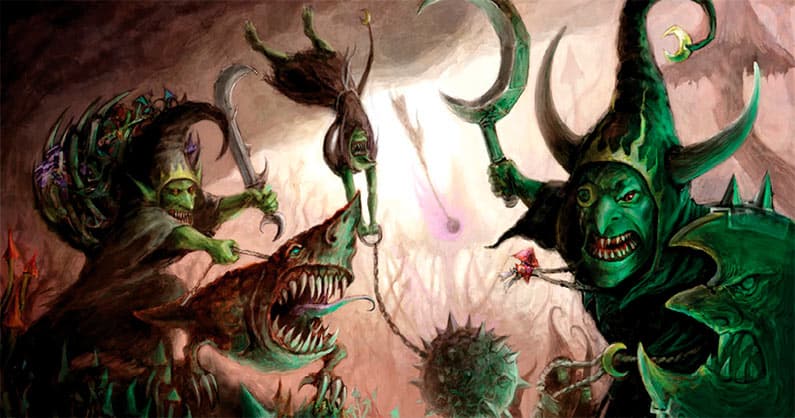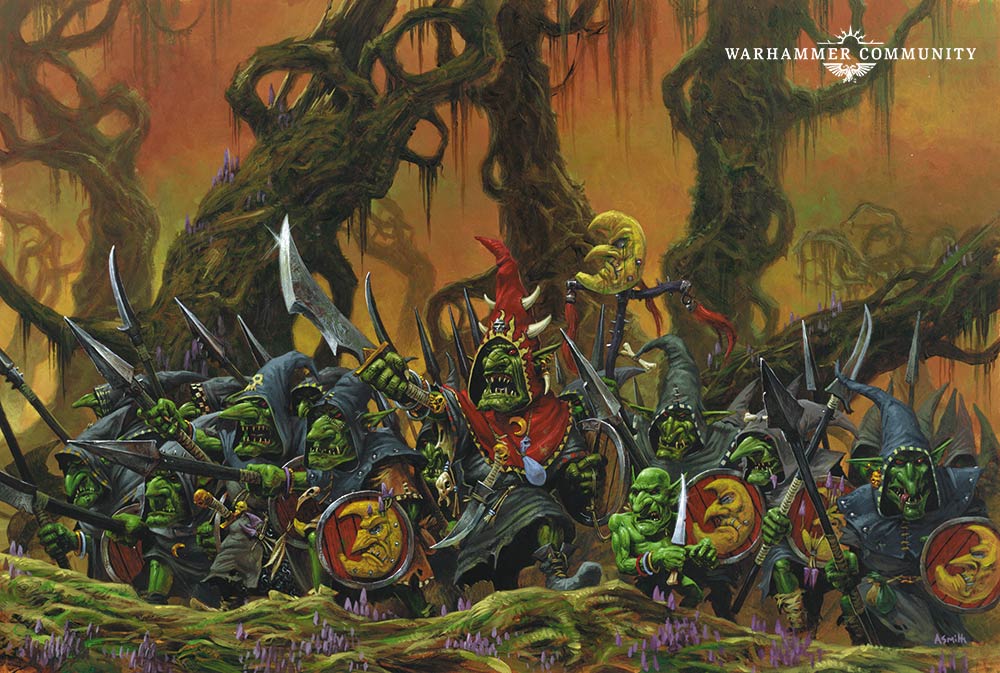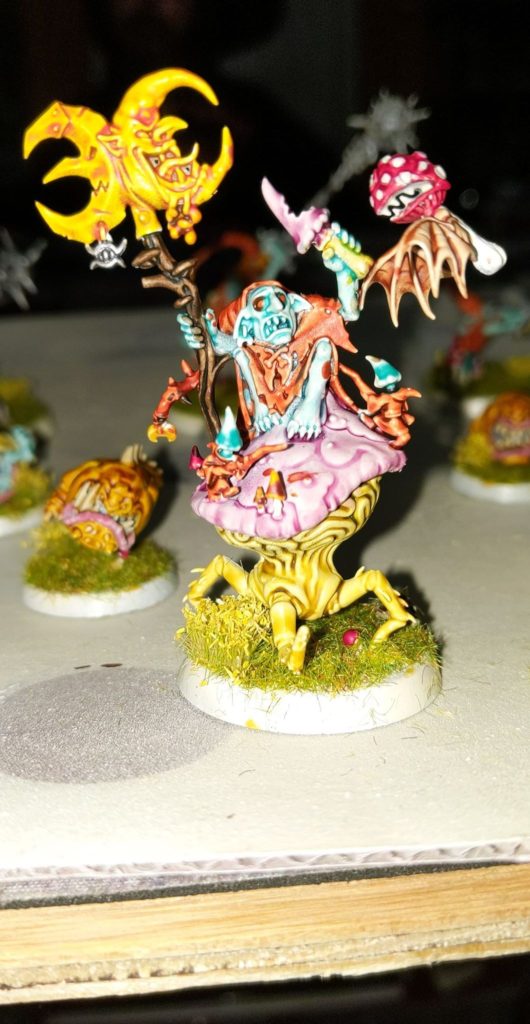A surprising army book represents my absolute favorite design in all of Age of Sigmar 2nd Edition. Let us find out what makes the Gloomspite Gitz both the peak of good design, but also a surprisingly competitive army!
In my quest to look at various armies for competitive Age of Sigmar, the Gloomspite Gitz have earned the very first faction focus, not only because they are capable of top-table play in the hands of a talented general, but because they manage to do it with great style.
While a lesser played army in the current meta, Gitz (formerly Grots) are my favorite of the currently released battletomes. There are a few reasons for that which I feel are worth addressing before we look at some more specific sneaky tricks, combos, etc.
A perfectly designed book is virtually impossible to pen. It needs excellent external balance against other armies so that it isn’t dead-on-arrival, and thus unplayed. The bigger issue is that it then needs a great internal balance between units. Doing the later ensures that players can pick models they enjoy, giving the whole range longevity, and makes sure a diversity of lists can exist. This often means a book will have to avoid obvious “auto-takes” (the absolute worst sin a designer can commit), and instead feature a range of subtle, solid options. If your book’s top tier unit/artifact/command ability is obvious from a five-minute Youtube flip-through… then as the kids say… you dun goofed.
Gitz could not be further from this, featuring several broadly distinct playstyles, all of which can be taken as a focus, or blended together, depending on your own gaming preferences.

Deep Magic Gitz: If played at bigger events, the most traditionally featured list digs into the volume of strong magic that Gitz can play on the table without compromising the armies ability to do other things as well. Staples of this list include several Fungoid Cave Shaman, an Arachnarok with caster, and a LOT of Endless Spells.
Secrets to Success – Gitz have some of the most insanely cost-efficient spell casting in the game, which opens the door to taking more Endless Spells than other armies, and not gimping your table presence in the process. Fungoids are absolute stars, generally earning back their points in Command Points alone, by the middle of the game, and also having two spell-casts once-per-game, thanks to a special ability. Burning these early will often put several Endless Spells on the table which both impede the opponent’s movement, disrupting plans in the process, but also usually laying down mortal-wound hurt, which is still a very powerful part of the AoS meta.
That isn’t to say you won’t also be using spells from the Lore’s available to the Gitz and friends. Hand of Gork is a game-winning repositioning tool that gets you the customary >9” away redeploy which all armies crave, but only a few get. Itchy Nuisance grants a model a debuff aura of -1 to hit in melee, which is particularly scary in an army filled with cheap Grot Netters who give a further -1 to hit. As a cheeky way to bring it all together, and Arachnacauldron technically becomes part of the model which cast it, but ignores placement rules if cast after Hand of Gork. Suddenly that spell-caster Arachnarok can have an easy, sneaky 5” charge, in the later game, where it can apply a surprisingly decent melee profile to a lightly defended objective or point of note.

The Horde: Chess clock users and people who don’t like batch painting need not apply, but for all others, Gitz have really impressive blobs of cheap bodies. The humble Grot Stabba can be fielded in units of 60 (if desired), all of which wound on a shocking 2+ if the remaining unit is at least thirty strong. The included netters require a bit of positioning finesse, but essentially always provide an in-built -1 to be hit in melee, while one of their banners does the same against shooting.
Secrets to Success – As with most things Gitz, real-world experience and skill in positioning will be well rewarded. Kept in range of the Loonshrine, a horde of Gitz are a surprisingly durable anvil who never fear battleshock. When finally (read: eventually) chewed through, a Command Point gives a chance on a 4+ to get a full half of the unit back on the table, for free. Fortunately, as a Gitz player, you are likely rolling in CP just waiting to be spent.
A bunch of relatively inexpensive support options help elevate these humble Grots from a solid battleline to something really threatening. A minimum unit of Sneaky Snufflers can grant the entire unit an additional attack, and a stock Loonboss on foot gives the unit additional mortal wounds on natural 6’s during said roll. Suddenly a very basic anvil to build one’s army around has a really surprising amount of offensive punch. If nothing else it makes an opponent play the mind-game of wondering if your anvil is bait, they really don’t want to get bogged down with, or if it is something they must contend with to win the objective game.
An obvious, but simultaneously fun trick to run is to also attach Loonsmasha Fanatics to the horde. This unit, secretly attached to a Grot unit in the pre-game, launches from said unit in EITHER players charge phase, and has an in-built “always strikes first” which is incredibly potent in the current competitive meta. While pricey, I feel like these glass-cannons can be extremely good, and are a very under-utilized unit. Never pass up a chance to play mind games when learning to raise your tournament standings.

Trolls: While the least common competitive army among the Gloomspite Gitz, I do feel like Trolls deserve a mention. Recent recipients of a points decrease, the Rockgut Troggoths, actually find themselves as one of the technically most points efficient units in the game. In larger units (generally six is a sweet-spot), these have some all-but-guaranteed free mortal-wounds on top of a surprisingly beefy melee profile for their modest cost. With 2” melee the otherwise unwieldy models will usually all contribute, too. Largely self sufficient, this units raw efficacy allows Troggoth heavy lists to sometimes punch above their weight-class. A small word of caution though. These become battleline only under a Troggboss General who himself is not great for his points. While a decent unit in some respects, having some Squigs as cheap battleline and backfield objective holders, may be the better bet.
Secret to Success – The Rockguts being great generally isn’t enough to justify going pure Troggoth, but for those inclined to try, or who simply like badass units, the Forgeworld Troggoth Hag can actually help in several Gitz lists. The Hag is, not unlike the Arachnarok, a competant hybrid caster and fighter. She comes with her own natural -1 to be hit, and her unique spell gives a further -1 to hit to a targeted unit. Now, it would be remiss of me to not remind you of those netters again, or that a caster buddy can also use Itchy Nuisance as well. If the hag doesn’t want to be hit, a Gitz player can make her a very uncommon tarpit that most of your local tournament players may not have seen coming.

In Closing: You may have noticed that I (intentionally) left a few pieces of the Gitz unmentioned. While the majority of Squigs from Boingrots to Manglers, and all in between have some strong rules and some legit tournament options, these generally come at the expense of a lot of points invested in desperately needed battalions and CP driven support abilities. Even then, the random movement of the army just doesn’t vibe with being a tournament player. Ideally, a major skill of competitive play is taking luck and randomness out of the equation whenever possible. An entire army of random just gives an uphill climb. That said, I love the models, and they can be legitimately strong, which helps me when I say how well designed this book really is.
The last omission is also my sole critique of the book. You may have wondered why I didn’t refer to the book’s allegiance abilities. Sadly, while a fluffy premise, the moon moving across the battlefield provides fairly minor buffs and debuffs. You certainly won’t ignore them, but they do precisely what they say they do, and generally don’t really change the standing of any particular unit in either good or bad ways.
That critique aside, I just love this book. The fun is very much there, and it fulfills my insistence on a great book offering multiple, valid, ways to win games. I often say that precisely because winning with a Gitz army isn’t easy, that the book is the benchmark that all AoS book writers should aspire to. It is a rich book filled with tools that reward practice and thoughtfulness, and I will take that over triple Keeper of Secrets any time.
Next up, a look at the Fyreslayers, and after that a deep dive into how to best finesse movement in AoS to the maximum advantage!
And remember, Frontline Gaming sells gaming products at a discount, every day in their webcart!




I am excited for these articles
Wow! Thank you so much! That means a lot to me. I’ll hopefully make them better and better as we go.
Wow, great article! Thanks for the insights.
Great analysis, thank you! I am excited to play my gitz for the first time soon, but they are just such great models, I have decided to paint them all haha…Do u have any suggestions for a gitz army list? I wanted to use some cavalry to support the little guys and some trolls to help with the heavy lifting